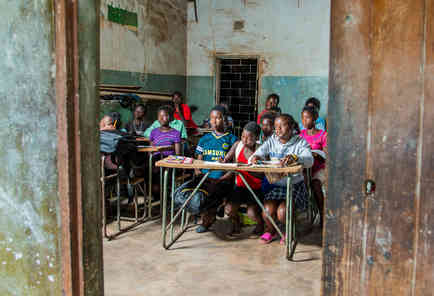VVOB in Cambodia made a video series with testimonials from gender role models and changemakers on violence-free schools and gender-responsive education in Cambodia. The testimonials are captured as part of the Teaching for Improved Gender Equality and Responsiveness (TIGER) project. In total, there are six testimonials in this video series.
Ms Tep Vandy, deputy director of Battambang Teacher Education College
In the first video, you will hear Ms Tep Vandy who manages all teaching of staff in the three departments (science, mathematics and language) of the Battambang Teacher Education College. Together with colleagues, she got involved in the Teaching for Improved Gender Equality and Responsiveness (TIGER) project. There she learned that to achieve gender equality, equal gender representations are important. She has implemented the concepts from the training in the management meetings at Battambang by encouraging participation from both men and women.“It is not only about being physically present in the meetings, all staff have equal rights in voicing their thoughts and making decisions”, Ms Vandy. Another implementation is that the management and curriculum development committee has incorporated the learned knowledge into the school curriculum. They merged this subject into the general study course for four hours with the topics: woman status in Cambodia, hidden curriculum, gender-responsive pedagogy, and leadership and gender-responsive lesson plan.
Ms Yin An, vice director of Anglong Vil Primary School
Ms Yin An is conscious of the past, where teachers used to speak more violently to their pupils. Other improvement points were the lesson plans, classroom decorations, seat arrangements, and in-class assignments. There was also very little attention paid to gender equality. Just as Ms Vandy, Ms An entered a training of the TIGER project. There she gained a lot of knowledge about positive discipline, how to communicate between the school and the community, how to keep a school safe, classroom management and how to provide a gender positive school environment. She has applied a lot and now regularly checks the teachers by observing lessons and reviewing the lesson plans to see if they have incorporated the gender aspect into the objectives. All this with success: the teachers rearranged the seats, the same classes are given to boys and girls (f.e. sewing and basic repair), there is less bullying, separate male and female toilets are installed, etc.Mr Yon Sokheng, teacher trainer at Battambang Teacher Education College
Mr Yon Sokheng has been teaching at Battambang College for nine years and used to not focus on the pupils but rather on himself to avoid making any mistakes. He would put on a very serious face during class. “One day, a pupil cried because I was using strict discipline, this made me realize that I had to change", Mr Sokheng. Thanks to the TIGER project, Mr Sokheng got interested in the concept of positive discipline: by showing good behaviour as a teacher, you encourage pupils to do the same. The coaching sessions that were part of TIGER made Sokheng reflect on himself, and now he pays more attention to his motivational language use, communication, cooperation and flexibility.Mr Roeut Bo, physics and chemistry teacher at Soheu Secondary school
Just as in the previous testimonials, Mr Roeut Bo knows that his way of teaching was not gender-responsive in the past. Moreover, he paid little attention to the underperforming pupils and encouraged only the outstanding ones, thus speeding up his educational process. After TIGER, he considers himself braver than before. Mr Bo: “I applied gender equality by for instance letting male and female students alter each other when answering a question. My students gained self-confidence and participate more. I encourage the less performing pupils by letting them verify an answer to an existing solution.”Phon Vanak, second-year student at the Battambang Teacher Education College
Phon Vanak, a student, used to avoid contact with the opposite gender in his secondary school because he was afraid of being bullied. It made him unhappy that he could not interact with females like he wanted to. Fortunately, he experienced how things are different at Battambang College. There, for example, the groups in group work are mixed with pupils of different genders and performance levels, which Vanak likes greatly. “The diversity enriches the group work, students learn more from each other, and it results in a deeper kind of learning experience”, says Vanak. As a future teacher, he plans to use the same methods when dividing groups. He will also promote that pupils can choose a profession regardless of their gender.Phy Srey Nich, grade five student at Samdach Chea Sim Primary School
The last testimony is from a fifth-grade pupil who is positive about the fact that she can now play football or jump rope with boys and girls, whereas that used to be different. When her teacher had arranged the places so that a boy sat next to a girl, Nich wondered why: "The teacher explained to me that it is for gender equality, this means equality between male and female pupils where both genders can do the same things. I am very grateful to have learned about gender."Subscribe to our (Dutch) newsletter
|
English





